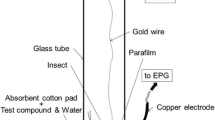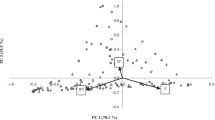Abstract
Diurnal locomotion and feeding activities of Trigonotylus caelestialium (Kirkaldy) and Stenotus rubrovittatus (Matsumura) were investigated using a video camera and electrical penetration graph. Diurnal locomotion activity of T. caelestialium was higher in photophase than in scotophase, whereas that of S. rubrovittatus was higher in scotophase than in photophase. No difference was observed in the locomotion activity of T. caelestialium between mated and unmated bugs or between males and females. Locomotion activity of S. rubrovittatus was different between the sexes. The activity of females was higher than that of males. Diurnal rhythms of feeding activity were obscure compared with those of the locomotion activities in both mirids. The feeding behavior of T. caelestialium was significantly more active in the photophase than in the scotophase. In S. rubrovittatus, feeding activity of males was higher in the scotophase than in the photophase, whereas females showed no such difference. It is thought that both species of mirid bugs are active during the daytime and nighttime, although the locomotion and feeding activities of T. caelestialium were high in the photophase, while those of S. rubrovittatus were high in the scotophase.






Similar content being viewed by others
References
Butler GD Jr (1972) Flight times of Lygus hesperus. J Econ Entomol 65:1299–1300
Caldwell RL, Dingle H (1967) The regulation of cyclic reproductive and feeding activity in the milkweed bug Oncopeltus by temperature and photoperiod. Biol Bull 133:510–525
Caldwell RL, Rankin MA (1974) Separation of migratory from feeding and reproductive behavior in Oncopeltus fasciatus. J Comp Physiol A 88:383–394
Carvalho GB, Kapahi P, Anderson DJ, Benzer S (2006) Allocrine modulation of feeding by the sex peptide of Drosophila. Curr Biol 16:692–696
Cline AR, Backus EA (2002) Correlations among AC electronic Monitoring waveforms, body postures, and stylet penetration behaviors of Lygus hesperus (Hemiptera: Miridae). Environ Entomol 31:538–549
Fujii T, Hori M, Matsuda K (2010a) Influence of host plant odours on invasion of the rice leaf bug Trigonotylus caelestialium into paddy fields. Agric Forest Entomol 12:99–105
Fujii T, Hori M, Matsuda K (2010b) Attractants for rice leaf bug, Trigonotylus caelestialium (Kirkaldy), are emitted from flowering rice panicles. J Chem Ecol 36:999–1005
Goto J, Higuchi H (2004) Preliminary evaluation of the flight ability of the rice leaf bug, Trigonotylus caelestialium (Kirkaldy) (Heteroptera: Miridae), investigated by tethered flight technique. Jpn J Appl Entomol Zool 48:219–224 (in Japanese with English summary)
Hachiya K (1999) Migration of rice leaf bug, Trigonotylus caelestialium (Kirkaldy) into rice fields and forecasting of the abundance. Plant Prot 53:268–272 (in Japanese)
Higuchi H, Takahashi A, Mima J (2001) Grasses used as host plants on oviposition by rice leaf bug, Trigonotylus caelestialium (Kirkaldy) (Heteroptera: Miridae), in autumn. Proc Assoc Plant Prot Hokuriku 49:15–17 (in Japanese)
Higuchi H, Takahashi A, Nagasawa A, Ishimoto M, Fukuyama M (2007) Daily periodicity of sex pheromone emission and mating in the rice leaf bug, Trigonotylus caelestialium (Kirkaldy) (Heteroptera: Miridae). Jpn J Appl Entomol Zool 51:51–54 (in Japanese with English summary)
Hori M (2009) Olfactory response of Stenotus rubrovittatus to rice and paddy weed, Scirpus juncoides. J Appl Entomol 133:438–443
Hori M, Enya S (2013) Attractiveness of synthetic volatile blends of flowering rice panicles to Trigonotylus caelestialium (Kirkaldy) (Heteroptera: Miridae). J Appl Entomol 137:97–103
Hori M, Namatame M (2013) Host plant volatiles responsible for the invasion of Stenotus rubrovittatus (Heteroptera: Miridae) into paddy fields. J Appl Entomol 137:340–346
Ishioka M, Kikuchi A, Kobayashi T (2004) Effect of some factors on flight activity of Trigonotylus caelestialium (Kirkaldy) (Heteroptera: Miridae) II. Effect of temperature. Ann Rep Plant Prot North Japan 55:143–145 (in Japanese)
Ishizaki M, Watanabe T, Moriya S, Tabuchi K (2011) Diurnal locomotion activity of adult rice bug, Leptocorisa chinensis (Hemiptera: Alydidae), at different ages, measured by actograph and video camera. Appl Entomol Zool 46:135–142
Kichishima T, Fukuyama M, Higuchi H, Takahashi A, Nagasawa A (2009) Daily periodicity of attraction for males to females and mating in the sorghum plant bug, Stenotus rubrovittatus (Matsumura). Jpn J Appl Entomol Zool 53:57–59 (in Japanese with English summary)
Kikuchi A, Kobayashi T (2003) Preference to spring gramineous weeds and Italian rye grass as food of Trigonotylus caelestialium (Kirkaldy) (Heteroptera: Miridae). Ann Rep Plant Prot North Japan 54:113–114 (in Japanese)
Mueller AJ, Stern VM (1973) Lygus flight and dispersal behavior. Environ Entomol 2:361–364
Nagano T, Fujisaki Y, Miyata M (1988) Seasonal prevalence of the sorghum plant bug, Stenotus rubrovittatus Matsumura, in Miyagi prefecture. Ann Rep Plant Prot North Japan 39:167–169 (in Japanese)
Nakada K (2000) Occurrence trend of the sorghum plant bug, Stenotus rubrovittatus Matsumura, in grass and rice fields. Plant Prot 54:316–321 (in Japanese)
Niiyama T, Fujii T, Hori M, Matsuda K (2007) Olfactory response of Trigonotylus caelestialium (Het.: Miridae) to rice plant and gramineous weeds. J Appl Entomol 131:513–517
Okutani-Akamatsu Y, Watanabe T, Azuma M (2007) Mating attraction by Stenotus rubrovittatus, (Heteroptera: Miridae) females and its relationship to ovarian development. J Econ Entomol 100:1276–1281
Okutani-Akamatsu Y, Watanabe T, Azuma M (2009) Mating behavior and oviposition of the sorghum plant bug, Stenotus rubrovittatus (Matsumura), (Heteroptera: Miridae) under laboratory conditions. Jpn J Appl Entomol Zool 53:13–20 (in Japanese with English summary)
Ono T, Kashin J, Kidokoro T (2007) Control of sorghum plant bug, Stenotus rubrovittatus (Matsumura) (Hemiptera: Miridae), in rice paddy field by grass mowing in relation to migration source. Ann Rep Plant Prot North Japan 58:75–79 (in Japanese)
Sato H, Ishimoto M, Yokoyama Y (2009) Seasonal prevalence of the sorghum plant bug, Stenotus rubrovittatus (Heteroptera: Miridae), in Niigata prefecture. Proc Assoc Plant Prot Hokuriku 58:7–12 (in Japanese)
Takahashi A, Higuchi H (2002) Efficiency of light trap for monitoring adult emergence of the overwintering generation of the rice leaf bug, Trigonotylus caelestialium (Kirkaldy) (Heteroptera: Miridae). Jpn J Appl Entomol Zool 46:163–168 (in Japanese with English summary)
Woodring JP, Clifford CW, Beckman BR (1979) Food utilization and metabolic efficiency in larval and adult house crickets. J Insect Physiol 25:903–912
Yokota H, Suzuki T (2007) Effects of heading frequency of gramineous weeds on population density of Stenotus rubrovittatus in footpath between paddy fields. Ann Rep Plant Prot North Japan 58:88–91 (in Japanese)
Zar JH (1999) Biostatistical analysis, 4th edn. Prentice Hall, New Jersey
Acknowledgments
We wish to thank Dr. Akihiko Takahashi (Hokuriku Research Center of NARO Agricultural Research Center) for providing cultures of T. caelestialium and S. rubrovittatus. We also thank the Gunma Rice Wheat and Soybean Promotion Association for providing wheat seeds. This work was supported by the JSPS (Japan Society for the Promotion of Science), KAKENHI grant no. 23380031.
Author information
Authors and Affiliations
Corresponding author
Rights and permissions
About this article
Cite this article
Suzuki, Y., Hori, M. Diurnal locomotion and feeding activities of two rice-ear bugs, Trigonotylus caelestialium and Stenotus rubrovittatus (Hemiptera: Heteroptera: Miridae). Appl Entomol Zool 49, 149–157 (2014). https://doi.org/10.1007/s13355-013-0234-y
Received:
Accepted:
Published:
Issue Date:
DOI: https://doi.org/10.1007/s13355-013-0234-y




